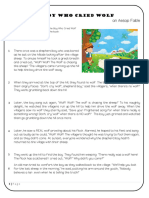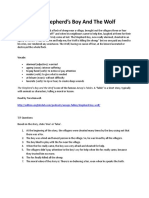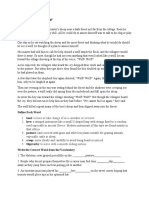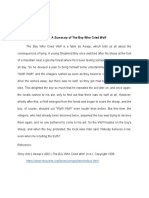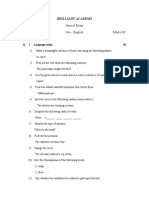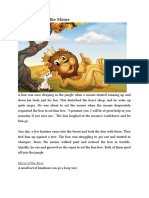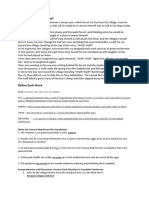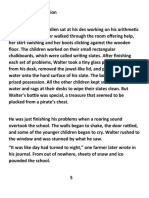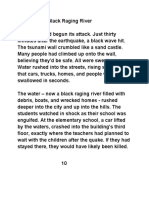Name:Class:
The Boy Who Cried Wolf
By Aesop620-560 B.C.
Aesop was a storyteller who lived in ancient Greece between 620 and 560 BCE. This story is part of hiscollection of tales known as “Aesop’s Fables,” which did not survive in writing but were passed down by people retelling them. They have deeply inuenced children's literature and modern storytelling culture.As you read, take notes on the details in the text that shape the main character, and how readers can learn from him.
There once was a shepherd boy who was bored as hesat on the hillside watching the village sheep. Toamuse himself he took a great breath and sang out,“Wolf! Wolf! The Wolf is chasing the sheep!”The villagers came running up the hill to help the boydrive the wolf away. But when they arrived at the topof the hill, they found no wolf. The boy laughed at thesight of their angry faces.“Don’t cry ‘wolf,’ shepherd boy,” said the villagers,“when there’s no wolf!” They went grumbling backdown the hill.Later, the boy sang out again, “Wolf! Wolf! The wolf is chasing the sheep!” To his naughty delight, he watchedthe villagers run up the hill to help him drive the wolf away.When the villagers saw no wolf they sternly said, “Save your frightened song for when there is really somethingwrong! Don’t cry ‘wolf’ when there is NO wolf!”But the boy just grinned and watched them go grumbling down the hill once more.Later, he saw a REAL wolf prowling about his ock. Alarmed, he leaped to his feet and sang out as loudly as hecould, “Wolf! Wolf!”But the villagers thought he was trying to fool them again, and so they didn’t come.At sunset, everyone wondered why the shepherd boy hadn’t returned to the village with their sheep. They wentup the hill to nd the boy. They found him weeping.“There really was a wolf here! The ock has scattered! I cried out, 'Wolf!' Why didn’t you come?”An old man triedto comfort the boy as they walked back to the village.
[1][5][10]1


The Boy Who Cried Wolf by Aesop is in the public domain.Unless otherwise noted, this content is licensed under theCC BY-NC-SA 4.0 license
“We’ll help you look for the lost sheep in the morning,” he said, putting his arm around the youth, “Nobodybelieves a liar...even when he is telling the truth!”
2
Text-Dependent Questions
Directions: For the following questions, choose the best answer or respond in complete sentences.
1.Why did the boy rst call out “wolf” in paragraph 1?A.He was afraidB.He was boredC.He wanted to see what he could get away withD.He was practicing2.In the end of the story, why didn’t the villagers come help the boy chase o the wolf?A.They were mad at himB.They thought he deserved his fateC.They didn’t believe himD.They were tired from running back and forth all day3.PART A: How does the boy’s relationship with the villagers change over time?A.At rst, the villagers support the boy, but by the end, they lose their trust in himB.At rst, the boy disrespects the villagers, but in the end, he gains their trustC.In the beginning, the boy works with the villagers to protect the sheep, but in theend, he is left all aloneD.At rst, the villagers love the boy, but in the end they refuse to support him4.PART B: Which detail from the text best supports the answer to Part A?A.“When the villagers saw no wolf they sternly said…” (Paragraph 5)B.“But the villagers thought he was trying to fool them again…” (Paragraph 8)C.“I cried out, ‘Wolf!’ Why didn’t you come?” (Paragraph 10)D.“‘We’ll help you look for the lost sheep in the morning,’ he said…” (Paragraph 11)5.Explain the line, “Nobody believes a liar...even when he is telling the truth!”3
Discussion Questions
Directions: Brainstorm your answers to the following questions in the space provided. Be prepared toshare your original ideas in a class discussion.
1.What do you think is meant by the last quote in the text? Why does “nobody believe a liar,even if he is telling the truth”?2.Does the boy abuse his power, squander it, or both? Explain your answer.3.What is the author’s message about power, truth, and lies? How are they connected? Useevidence from this text, from your own experience, and from other art or literature toanswer this question.4










